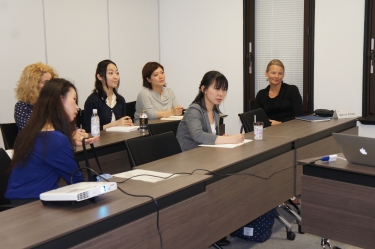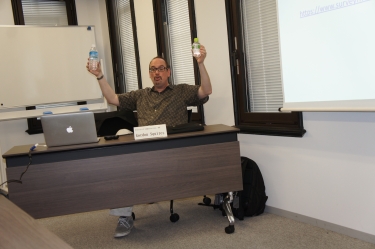WEPOC and the Thirty Meter Telescope: The Fourth International Public Relations Workshop Held

Date of activity: May 30, 2016
What is WEPOC, why is it important and what does it have to do with the proposed Thirty Meter Telescope (TMT)? These questions and more were discussed at the fourth international public relations workshop held at the University of Tokyo on May 30th, 2016. Over a dozen University of Tokyo public relations officers attended the event, which featured a presentation by Dr. Gordon K. Squires, the director of the California Institute of Technology (Caltech)'s IPAC Communications and Education group and the director of WEPOC for the TMT project. Joining him was Janesse Brewer, a senior communications practitioner who has worked on the TMT project since 2007.
The Thirty Meter Telescope is a proposed telescope to be built on Mauna Kea in Hawaii. When completed in the late 2020s, it will be the most advanced optical telescope on Earth. Construction of this telescope is a multinational effort, with the governments of the United States, Japan, China, India and Canada supporting the project. Dr. Squires is in charge of communications for the project, and he discussed the multifaceted approach his team takes in their work, which is summarized by the acronym WEPOC. WEPOC stands for Workforce development, Education (formal and informal), Public Outreach and Communications and acts as a fundamental component of the TMT project.
Before becoming involved with the TMT, Dr. Squires and his team had worked on communications for one of NASA's Great Observatories, the Spitzer Space Telescope. While achieving success in this project at first, the team was plagued with gradually increasing budget cuts and abrupt changes in PR strategy. They decided to change their own strategy and began conducting communications activities for smaller astronomy projects within Caltech, conducting education and public outreach events, creating science visualizations and promotional media, handling media relations, developing websites, and doing other similar services for these projects.
Through this new strategy, Dr. Squires and his team soon started administering communications for the TMT. For instance, to address local cultural and environmental concerns regarding the telescope's construction, the team is employing the philosophy of WEPOC. Dr. Squires said that each part of WEPOC has been very important to the core of the TMT project, and without his team, the project would not exist today. He told the participants that his experiences with the TMT show that PR for a large international science project is just as important as the science itself, and should be treated accordingly.
The presentation was followed by a lively Q&A session, in which participants asked Dr. Squires about the inclusion of workforce development in WEPOC, the dialogue between the TMT team and the people of Hawaii, crisis communications, how to convince members of your organization that WEPOC is important, juggling both a scientific career and WEPOC activities, Dr. Squires' involvement with the LIGO (Laser Interferometer Gravitational-Wave Observatory) gravitational waves discovery, and even how he voted in the monumental decision to downgrade Pluto to dwarf planet status.
Many participants stayed after the highly stimulating event to talk further with Dr. Squires and Ms. Brewer about their experiences and exchange ideas on how to best utilize the WEPOC approach in their work.
* Starting from AY 2016, the International Public Relations Workshops are jointly organized by the Division for Strategic Public Relations and the Division of International Affairs.

Dr. Squires giving his presentation, with Ms. Brewer seated on the left 
Participants taking notes and listening intently to Dr. Squires' presentation 
Dr. Squires likening his plastic water bottles to Pluto and its moon, Charon






